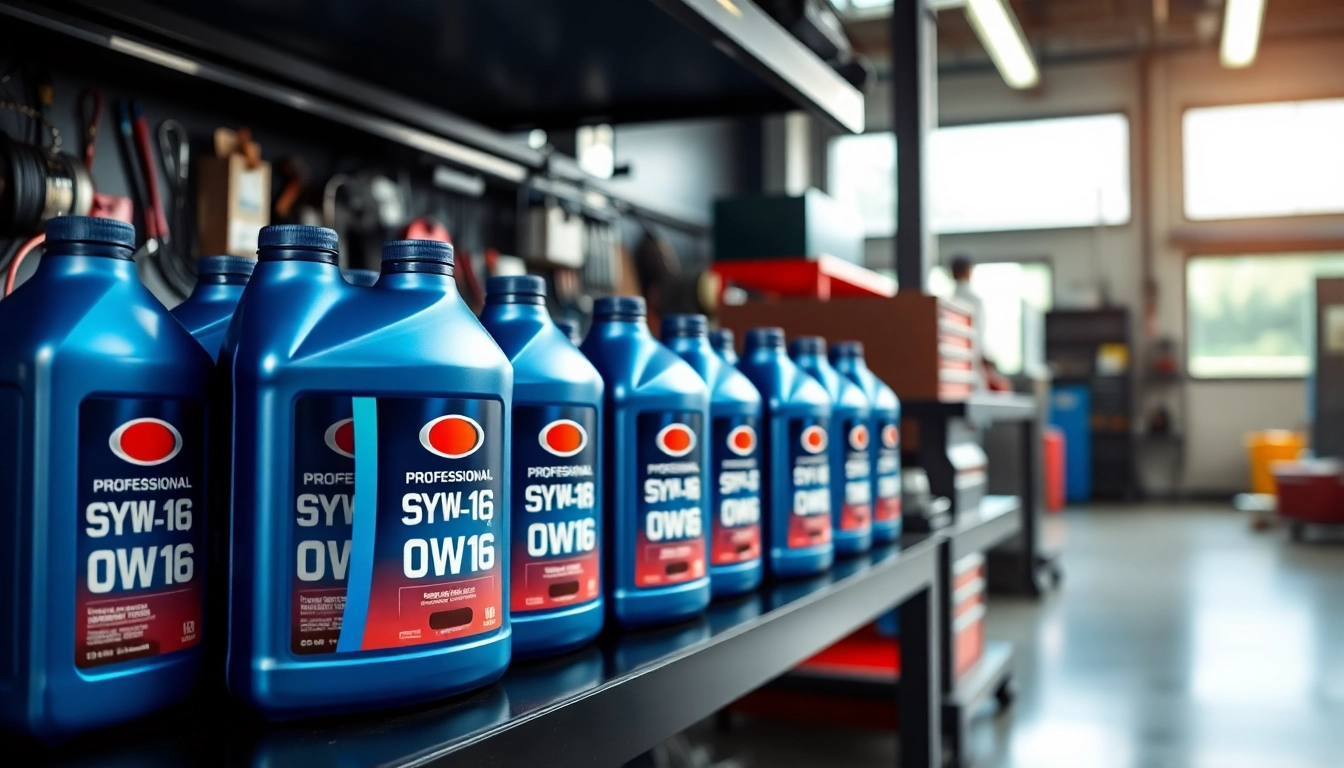What is 0W-16 Oil?
0W-16 oil is a specific grade of engine oil that belongs to the 0W-16 oil viscosity category established by the Society of Automotive Engineers (SAE). The “0” in the viscosity rating indicates how the oil behaves at low temperatures, while the “16” reflects its viscosity characteristics at higher temperatures. This grade is designed primarily for modern gasoline engines, particularly for fuel-efficient and hybrid models. It provides a thinner oil formulation compared to the more traditional grades like 5W-30 or 10W-30, characterized by its improved performance in colder weather conditions.
Properties of 0W-16 Oil
0W-16 oil is formulated to provide excellent protection for engines while optimizing fuel economy. Some key properties include:
- Low Viscosity: Its low viscosity allows for easier flow through the engine and quicker lubrication during cold starts, reducing wear on engine components.
- Fuel Efficiency: The lighter weight allows vehicles to achieve better fuel economy, which is particularly beneficial for drivers concerned about costs and sustainability.
- High Performance at Low Temperatures: This oil maintains its viscosity and doesn’t thicken as quickly in cold weather, ensuring that engines start smoothly even in frigid conditions.
How 0W-16 Oil Compares to Other Oil Grades
When comparing 0W-16 oil to other viscosity grades, like 0W-20 or 5W-30, one can observe several important differences:
- Viscosity at High Temperatures: 0W-16 is thinner at operating temperatures than 0W-20. This difference can lead to better fuel economy, but it necessitates that vehicles using 0W-16 be designed specifically for this viscosity.
- Cold Weather Performance: Both 0W-16 and 0W-20 perform similarly at low temperatures, but 0W-16 has an edge due to its reduced thickness.
- Engine Compatibility: It’s essential to check manufacturer recommendations before switching oil types, as using a different viscosity than specified brings risks like reduced engine protection and increased fuel consumption.
Common Uses for 0W-16 Oil
0W-16 oil is commonly recommended for several modern vehicles, largely those that aim for improved fuel efficiency through advanced engineering. Popular models that typically use 0W-16 oil include:
- Toyota Prius
- Toyota Camry (certain trims)
- Toyota RAV4 Hybrid
- Subaru Crosstrek Hybrid
- Mazda vehicles with SKYACTIV technology
Benefits of Using 0W-16 Oil
Choosing the correct motor oil not only enhances vehicle performance but also extends engine life. Here are the key benefits that 0W-16 oil offers:
Fuel Economy Advantages
As fuel prices continue to rise, the fuel efficiency granted by 0W-16 oil is a significant consideration. The lighter nature of 0W-16 oil means that engines can operate more efficiently with less energy required to pump oil through the system. This efficiency can result in noticeable fuel savings, especially over extended periods of usage. Many drivers have reported figures pointing to a difference of up to 2% in fuel economy simply by using the manufacturer-recommended oil viscosity.
Engine Protection Features
0W-16 is formulated to reduce engine wear, primarily due to its superior lubricating properties. It creates a protective layer on critical engine components, thereby minimizing friction and wear during operation. This aspect is particularly crucial for hybrid vehicles which often operate under different temperature conditions compared to traditional vehicles. Furthermore, the robust detergent additives in synthetic formulations help keep engine internals clean, preventing sludge buildup and ensuring consistent performance over time.
Performance in Various Conditions
The versatility of 0W-16 oil allows it to perform effectively across various temperature ranges. Its formulation is designed to adapt, maintaining protective qualities from cold starts to elevated operations. Studies have shown that vehicles using 0W-16 oil perform better in both urban traffic conditions (often involving stop-and-go) and on highways, where consistent lubrication is essential for maintaining engine temperature and efficiency.
Choosing the Right 0W-16 Oil for Your Vehicle
Given the importance of using the right oil for your vehicle, selecting a suitable 0W-16 oil can be essential for optimal engine performance. Here’s how to go about it:
Understanding Manufacturer Specifications
Before selecting any motor oil, always refer to your vehicle’s owner’s manual. The manufacturer will generally specify the recommended oil grade, which is usually determined through rigorous testing procedures. Vehicle models designed to operate on 0W-16 typically have components engineered to maximize its benefits. Using a different viscosity not only negates the advantages but may also void the warranty in some cases.
Top Brands of 0W-16 Oil
Brand reputation can play an important role in oil selection. Some of the most recognized providers of 0W-16 oil include:
- Mobil 1: Known for their high-performance synthetic oils that excel in fuel efficiency and engine protection.
- Valvoline: Offers advanced full synthetic options that feature superior protection against engine contaminants.
- Castrol: Their synthetic range often focuses on maximizing performance while maintaining engine cleanliness.
- Toyota: As the manufacturer, they produce their own 0W-16 oil that is specifically tailored for their vehicles.
Evaluating Synthetic vs Conventional Options
0W-16 oil is mostly available in synthetic formulations, and for good reason. Synthetic oils generally outperform conventional oils in almost every aspect, such as:
- Temperature Resistance: Synthesized oils can withstand a broader range of temperatures without losing viscosity.
- Longevity: They often have extended oil change intervals due to their superior resistance to breakdown.
- Cleaner Operation: Advanced detergents in synthetic oils can trap and carry away contaminants, resulting in a cleaner engine over time.
Conventional oils may still be an option for older vehicles specifically designed for higher viscosity oils, but for most modern engines utilizing 0W-16, a synthetic option is encouraged.
How to Change 0W-16 Oil: Step-by-Step Guide
Changing your vehicle’s oil is a crucial aspect of maintenance. Here’s a comprehensive guide to changing 0W-16 oil, ensuring your engine continues to perform optimally:
Required Tools and Materials
To perform an oil change, you will need the following:
- 0W-16 motor oil
- Oil filter (compatible with your vehicle model)
- Oil filter wrench
- Socket set or wrench
- Oil catch pan
- Funnel
- Rags or paper towels
Procedure for Oil Change
- Prepare the Vehicle: Park your vehicle on a flat surface and turn off the engine. Allow it to cool down if it has been running.
- Remove the Oil Cap: Open the hood and remove the oil cap to allow better drainage of old oil.
- Drain the Old Oil: Place the oil catch pan under the oil pan and remove the drain plug, allowing the oil to drain completely. Replace the drain plug once all oil has drained.
- Replace the Oil Filter: Use the oil filter wrench to remove the old oil filter. Before installing the new filter, apply a little new oil to the gasket of the new filter for a better seal.
- Add New Oil: Using a funnel, pour the required amount of 0W-16 oil into the engine through the oil fill cap.
- Check Oil Levels: Start the engine and let it run for a minute. Turn it off, wait a few moments, and then check the oil level with the dipstick. Add more oil if necessary.
Disposal and Environmental Considerations
After changing the oil, it’s important to dispose of the old oil properly. Many auto parts stores and municipal waste disposal sites will accept used oil for recycling. Avoid pouring the oil down the drain, as it can contaminate local waterways and harm the environment.
Frequently Asked Questions about 0W-16 Oil
What Are the Differences Between 0W-16 and 0W-20?
The primary difference between 0W-16 and 0W-20 oil lies in their viscosity at higher temperatures. While 0W-16 is thinner and designed for enhanced fuel economy, 0W-20 offers slight improvements in performance under heavier loads. Both grades function well in cold temperatures but choosing the correct one based on your vehicle’s specifications is crucial.
Can You Use 5W-20 Instead of 0W-16?
No, using 5W-20 instead of 0W-16 is not recommended unless specifically authorized by the manufacturer’s guidelines. The difference in viscosity can lead to inadequate lubrication and higher wear on engine components, leading to performance issues or even engine damage over time.
Recommended Oil Change Intervals
For vehicles using 0W-16 oil, it’s generally recommended to change the oil every 10,000 miles or once a year, whichever comes first, although specific intervals may vary based on driving conditions and manufacturer recommendations. Keeping track of oil condition through regular checks can help maximize performance and longevity.















Leave a Reply